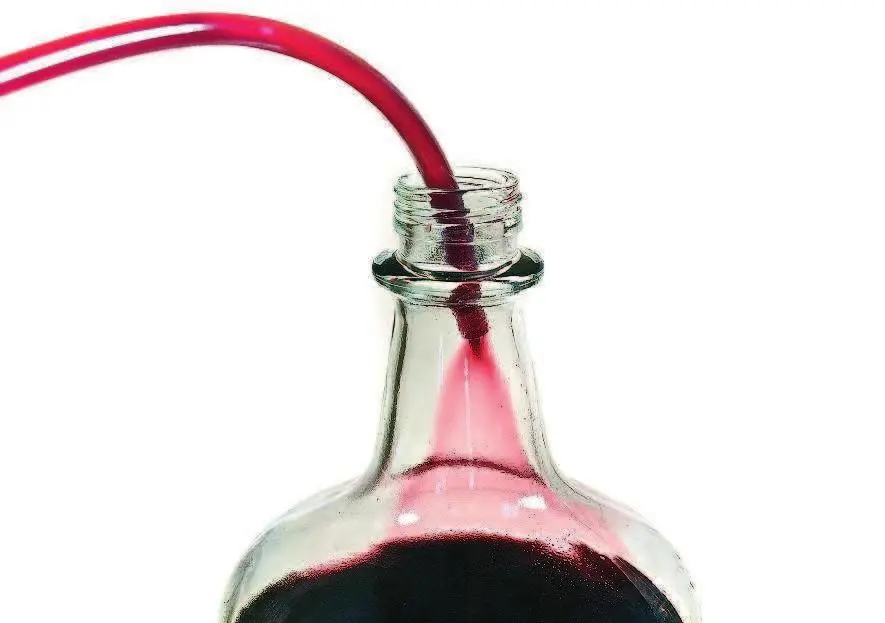Contents
Aeration (aeration) of homemade wine is a technological process of saturating the drink with oxygen to eliminate certain defects and defects, as well as oxidizing unstable particles in order to accelerate the formation of sediment. The procedure is relevant for young fermented wines, but is sometimes used during fermentation and even aging (for sherry and madeira).
The essence of the method
At home, airing is carried out by pouring wine from one container to another in the open air.

Ventilation of wine contributes
1. An increase in the amount of yeast during the period of active fermentation. With access to air, yeast fungi multiply intensively, when oxygen runs out, the yeast stops multiplying and begins to process sugar into alcohol. Airing at the fermentation stage is relevant if the juice was immediately placed under a water seal without aging in a container with a wide neck. In this case, the sediment is not removed during transfusion.
2. Removal of residual carbon dioxide after fermentation. Carbon dioxide almost always remains in the inner layers of a young wine that has aged, it is harmless, but it makes the drink slightly carbonated, which does not fit into the style of still wines.
3. Getting rid of the smell of hydrogen sulfide (rotten eggs). An unpleasant smell appears if the wine is not removed from the sediment for a long time, when the must is infected with a specific strain of wild yeast that produces hydrogen sulfide, and also when the container is fumigated with sulfur too much. The only way to solve the problem is periodic ventilation.
4. Prevention of anaerobic wine diseases (“obesity”). Obesity is typical for sweet wines with low acidity, the activation of bacteria Bacillus viscosus vini leads to the fact that mucus appears in the wine, then the drink gradually thickens. Oxygen entering the must during aeration inhibits the activity of Bacillus viscosus vini, and the winemaker gains a little time to save the wine: pasteurize, increase acidity and ferment again.
5. Acceleration of oxidative processes. As a result, the sediment forms and falls out more intensively, and the wine matures faster.
Disadvantages of ventilation
1. The likelihood of contamination of the wort by pathogenic microorganisms. Since at home ventilation is carried out by open pouring wine from one container to another, there is a risk of contaminating the drink with microorganisms in the air, such as mold spores or lactic acid bacteria. Therefore, immediately after the transfusion, it is necessary to provide conditions unfavorable for the development of microorganisms: lack of access to air and sunlight, low temperature, optimal humidity.
2. Souring. With the access of oxygen in the wine, acetic bacteria are activated, processing alcohol into acid. The wine slightly sours, oxidizes and ages faster. For young drinks, this is not terrible and often even useful, but for aged wines, oxidation can be fatal, spoiling the aroma and taste.
3. Evaporation. During ventilation, part of the wine evaporates, but the losses are insignificant (usually less than 0,5%) and they are fought only on an industrial scale. At large enterprises, wine for ventilation is pumped between tanks in a closed system, where pure oxygen is dosed.
Periodicity. In most cases, ventilation of homemade wine is combined with filtration (removal from sediment). In the first 4-6 months of aging, depending on the intensity of the appearance of sediment, up to 3 filtrations per month (usually 1-2) are done, then the wine is bottled for storage and no longer disturbed. It is advisable to air the wine separately from the sediment removal only if there is a smell of hydrogen sulfide, signs of “obesity” or “blackening” (contact with metal).
wine ventilation technology
1. Raise the container with wine above the floor level to a height of 30-60 cm, while moving the wine carefully, trying not to disturb the sediment.
2. Open the container or remove the water seal. One end of the tube (length 1-2 meters, diameter 0,5-1,5 cm) is lowered into wine. The tube should be at a distance of about 3-4 cm from the sediment.
3. Suck wine slightly through the other end (like gasoline from a tank), then lower the other end of the tube into the neck of a receiving container located on the floor. The greater the height of the fall of the wine (from the end of the tube to the bottom), the better.

It is advisable to additionally direct a stream of wine to the walls of the receiving container so that the drink comes into contact with air more.
4. Control the process so that the tube does not touch the sediment.
In the absence of a tube, simply pour the wine several times from one container to another from the maximum height.
5. After transfusion (it is desirable to fill the container with fermented wine to the top) hermetically close.









